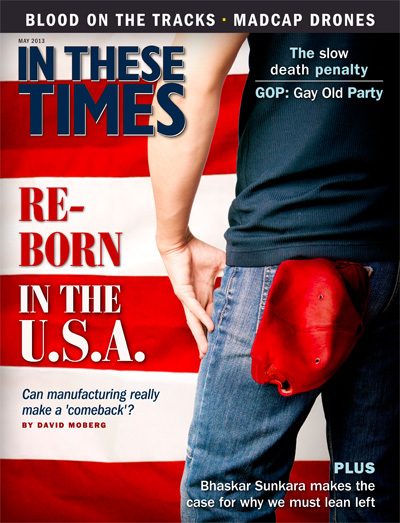Can Co-ops Save Unions?
Labor-cooperative partnerships may herald a new strategy for labor--if they can get off the ground.
Rebecca Burns

What has 18 owners, no bosses and high hopes for fostering workplace democracy in America? New Era Windows LLC, a worker-owned cooperative formed last year by members of United Electrical Workers (UE) Local 1110.
After occupying their factory to save their jobs — twice — workers at a closing Chicago windows plant decided last year to try a new tack: running the business themselves. They purchased equipment from their former bosses and are now setting up a new factory they believe will create good jobs in the city’s depressed economy.
New Era is one of a growing number of union-backed cooperatives nationwide that could herald a new strategy for labor. In his survey of existing cooperatives, economist Gar Alperovitz has calculated that the number of workers in partly or wholly employee-owned companies now exceeds those who belong to private-sector unions — a statistic that speaks both to the perilous state of the labor movement and the promise of reviving it through new structures.
In the case of New Era, the decision to form a cooperative was the result of a long battle with management. In 2008, upon being told that their factory would be closed and they would be fired immediately without severance pay, workers staged a six-day occupation of the Republic Windows and Doors factory and emerged victorious. Their stand, coming at the height of the financial crisis, was celebrated nationwide. It also emboldened them to occupy once again in February 2012, when new owner Serious Energy announced that it, too, would be closing the plant. The workers’ journey from occupiers to owners was paved in part by UE’s tradition of militancy, which some progressives hoped would inspire other unions fighting mass layoffs.
The labor movement at large hasn’t reprised the 1930s-era tactic of occupying factories in order to regain a foothold in existing workplaces. But a growing number of unions, led by the United Steelworkers (USW), are exploring creation of new worker-owned cooperatives as a strategy for contending with the offshoring of U.S. jobs. Like the workers who formed New Era Windows, USW began experimenting with cooperatives partly out of necessity — as job losses mounted amidst the financial crisis, “there seemed to be an opening to consider how we might create a better model, because everything was falling apart,” says Rob Witherell, USW’s cooperative strategist. USW decided to partner with Mondragon, Spain’s famous group of cooperatives, to create a template for union co-ops.
Now, USW is helping launch several pilot projects, including a green laundry in Pittsburgh that could replace some of the 100-plus jobs lost when an industrial laundry in the area closed several years ago. Members of United Food and Commercial Workers are currently employed in an urban farming cooperative in Cincinnati, with more projects planned under the behest of the Cincinnati Union Cooperative Initiative.
Union-cooperative partnerships are hardly a new idea. Following the 1842 judicial decision formally granting the right to unionize, the nascent American labor movement experimented with both forms of organization. But today only a “tiny fraction” of worker-owned cooperatives are unionized, according to Melissa Hoover, executive director of the U.S. Federation of Worker Cooperatives. Most current unionized co-ops have emerged directly out of labor battles — such as the unionized exotic dancers’ co-op Lusty Lady and now New Era Windows, which has already formed a new UE local.
Though many worker co-ops feel an ideological affinity with unions, Hoover notes, they’ve been “unable to make much headway in forging connections,” in part because of the scale differential between the two movements. “I think the real game-changer will come from the union side,” says Hoover. “As unions take more interest in cooperatives, they are developing new structures.”
Why would a cooperative, which already espouses worker control, need a union? In larger-scale co-ops, worker-owners frequently elect a board of directors to provide oversight for day-to-day operations. While this body is tasked with watching over members’ interests as owners, it often isn’t as attuned to their issues as workers, notes a 2012 report from USW, Mondragon and the Ohio Employee Ownership Center. In the union co-op model, a union committee bargains with the elected management over wages and benefits and also ensures that all worker-owners have access to due process over workplace disputes. Unionized co-ops could therefore help scale up experiments in worker-ownership without ceding their values.
Still, there are limitations to cooperatives as a strategy for broader change. Since they must continue to compete in a capitalist market, cooperative enterprises may eventually begin behaving like capitalist ones. In his 2012 collection Rebel Cities, urban studies theorist David Harvey notes that historical attempts to create havens of worker control have tended either to collapse or force workers into a position of “self-exploitation.”
Not least among the challenges facing worker-owned co-ops is how to secure capital’s support for a venture aimed, in essence, at undermining the laws of capital. For that reason, worker-owned cooperatives have sprung up fastest in the service sector, where the initial investment required is fairly low. Breaking into the capital-intensive manufacturing sector presents a much greater hurdle.
So far, New Era Windows has raised $500,000 for factory equipment through the Working World, a development fund for cooperatives. But more will likely be needed. Traditional loans and venture capital are difficult for new cooperatives to attract, says Brendan Martin, president of the Working World — and often prove inimical to the value of worker control. A better strategy, he says, is to seek zero- or low-interest investments from community partners who would like to see green, union jobs in the area.
“Securing financing is going to be crucial to bringing this to scale,” says USW’s Witherell. This could mean initially diluting worker ownership, he says, “but you piece together a group of friendly investors who are willing to put some patient capital toward the project, and cede control to the workers over time.” USW is also exploring the purchasing power of local institutions, by seeking commitments from local hospitals and universities to purchase from the Pittsburgh green laundry once it is up and running. As another example of financing options, he points to the Solidarity Fund, an initiative by the Quebec Labor Federation in 1983 to invest in organized and socially responsible businesses that has grown into a $7 billion fund.
It remains to be seen what collective bargaining agreements might look like for new union co-ops — especially given that autonomy from outside organizations is a key principle of cooperatives, potentially making industry-wide solidarity more difficult. The Bronx’s Cooperative Home Care Associates (CHCA), however, provides one clear example of how unionized cooperatives can serve both aims. With over 2,000 members, CHCA is the largest worker-owned co-op in the United States and a member of Service Employees International Union 1199. Initially, the coop was reluctant to embrace union affiliation, given that CHCA’s home health aides already had better pay and working conditions than most of their counterparts. But greater coordination between home care workers, management realized, could help raise the competition’s costs closer to its own and promote industry-wide improvements. An agreement was reached in 2004, and CHCA and SEIU have created an innovative labor-management council structure.
Finally, there’s a question of whether union co-ops can really tip the balance of power between workers and owners in more than a handful of initiatives. Asked whether union co-ops could take on the forces of globalization, or whether they’re best suited to fill niche markets for production of local goods and services, Witherell notes that worker-owners are unlikely to outsource their own jobs, and points to Mondragon’s approach of “multi-localization,” where “adding jobs abroad helps add jobs at home.” (Part of Mondragon’s strategy to cope with the recession, however, has been to create subsidiaries in other parts of the world, with the result that less than half of its workforce is now comprised of cooperative members. While non-members may still be treated better than in capitalist businesses, some critics have argued that this reintroduces the dynamic of exploitation.)
The workers at New Era Windows have found that it takes more than simple incorporation as a cooperative to build power. Five months after Serious Energy promised to give them time to find a new buyer for the plant, New Era was told suddenly that the factory would be liquidated. It was only through another mass, UE-backed protest against Serious investor Mesirow Financial that the new worker-owners were granted enough time to come up with a bid on the equipment. But they are optimistic that continued organizing and community support can help them prevent future flights of capital and keep union jobs in Chicago.
Martin also hopes that New Era Windows’ continued UE affiliation will revive the labor movement’s interest in cooperatives. “If unions figure out that cooperatives aren’t threatening to them and are instead a source of power,” he says, “that’ll have a big impact on where labor can go.”
Rebecca Burns is In These Times’ housing editor and an award-winning investigative reporter. Her work has appeared in Business Insider, the Chicago Reader, the Intercept, ProPublica Illinois and other outlets.









